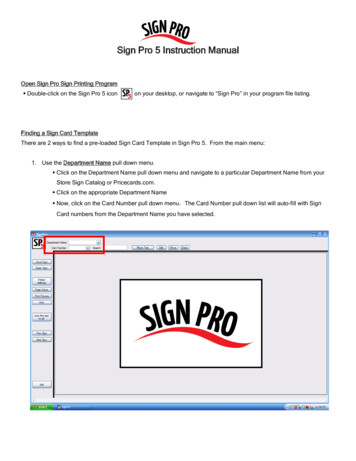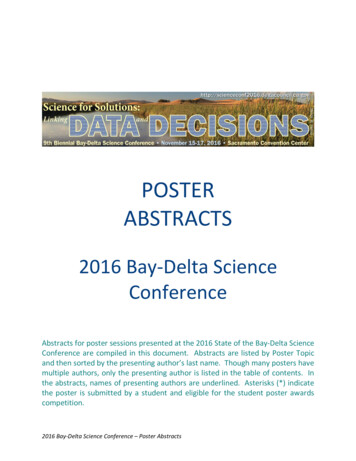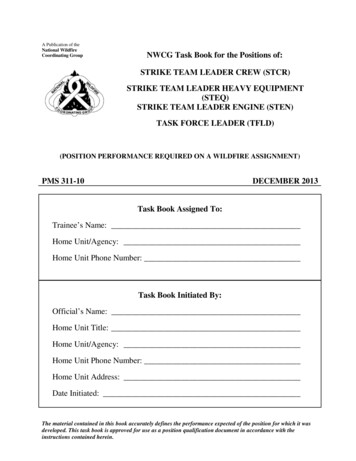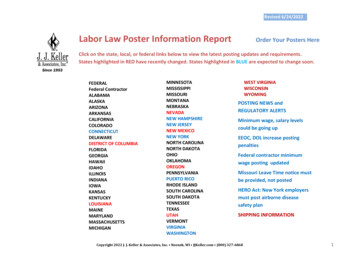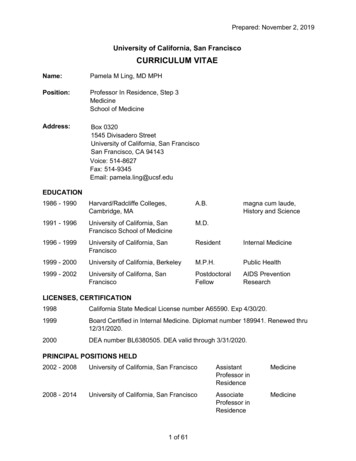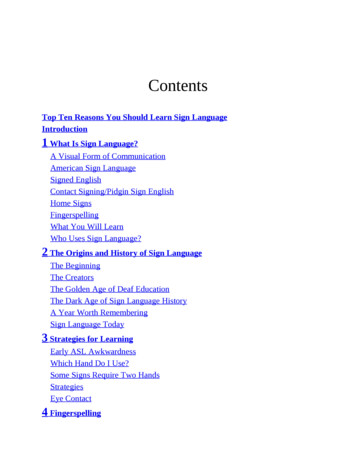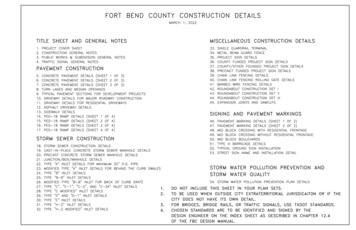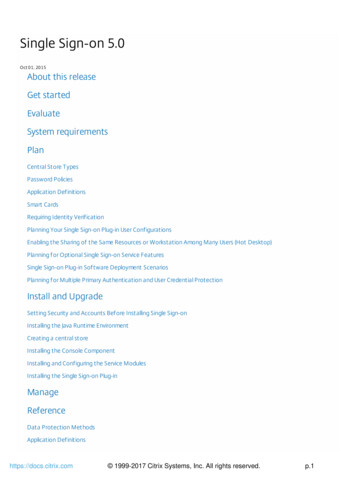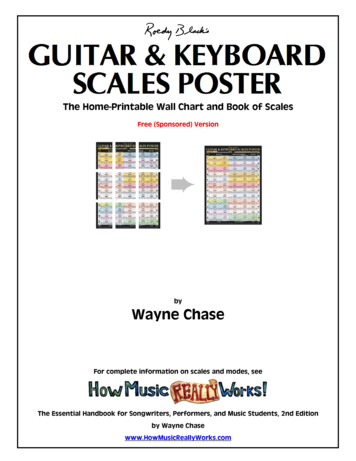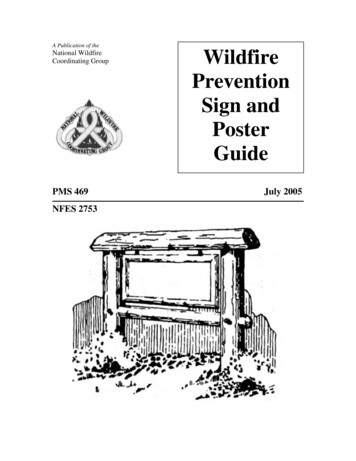
Transcription
A Publication of theNational WildfireCoordinating GroupPMS 469NFES 2753WildfirePreventionSign andPosterGuideJuly 2005
Wildfire PreventionSign and Poster GuidePMS 469July 2005NFES 2753A publication of the NWCG Wildland Fire Education Working TeamWritten and compiled by Peter MartinConsultation by Jeannette HartogAdditional copies of this publication may be ordered from: National Interagency Fire Center,Attn: Great Basin Cache Supply Office, 3833 S. Development Avenue, Boise ID 83705. OrderNFES 2753.This document, and other Wildfire Prevention Guides, is available in PDF format at thefollowing website:https://www.nwcg.gov
PrefaceThis wildfire prevention guide is a project of the National Wildfire CoordinatingGroup and is one in a series designed to provide information and guidance forpersonnel who have interests and/or responsibilities in fire prevention. The goal ofthis series is to improve and enhance wildfire prevention programs and to facilitatethe achievement of NWCG program goals.Each guide in the series addresses an individual component of a fire preventionprogram. In addition to providing insight and useful information, each guidesuggests implementation strategies and examples for utilizing this information.Each wildfire prevention guide has been developed by fire prevention specialistsand subject matter experts in the appropriate area.NWCG Wildfire Prevention Guide development: Conducting School Programs (1996) Event Management (1996) Wildfire Prevention Marketing (1996) Wildfire Prevention and the Media (1998) Wildfire Prevention Strategies (1998) Effective Wildfire Prevention Patrol (1998) Recreation Area Fire Prevention (1999) Fire Communication and Education (1999) Fire Education Exhibits and Displays (1999) Industrial Operations Fire Prevention Guide (1999) Establishing Fire Prevention Education Cooperative Programs andPartnerships (1999) Participating on Wildland Fire Prevention Education Teams Guide (2005) Wildfire Prevention Sign and Poster Guide (2005)-i-
- ii -
Contents1.0IntroductionDefinitions for signs and posters . 12.0Principles and GuidelinesEffectiveness of signs and posters . 2Sign placement and installation . 3Sign characteristics . 8Helpful rules for developing your message . 8Lettering sizes . 9Abbreviations . 10Symbol sizes . 10Sign substrate materials . 11Sign supports . 13Sign maintenance . 153.0PostersTypes of messages . 16Application . 17Message selection . 18Poster maintenance . 20Sources of posters . 21Poster mounts selection and designs . 244.0Plans and DocumentationPrevention sign plan contents . 355.0Fire Danger Rating SignPlacement . 38- iii -
National Fire Danger Rating System. 39Fire Wheel Rating sign . 40Smokey Bear fire danger sign . 416.0Signs for Special LocationsRange poster . 44Bill boards . 44Sequential signs . 45Burma Shave style . 45Banners . 46Campfire stakes . 47Information stations . 49FiguresFigure 2-1 Typical installations for low-volume rural roads . 6Figure 2-2 Driver’s Cone of Vision . 7Figure 2-3 Breakaway sign support guidelines. 14Figure 3-1 Large size display style . 25Figure 3-2 Large size sliding panel style . 26Figure 3-3 Medium size rustic style . 29Figure 3-4 Medium size simple styles #1 and #2 . 30Figure 3-5 Small poster mount for 12”x18” . 32Figure 3-6 Small poster mount for 12”x14” . 33AppendicesAppendix A: Sample wildfire prevention sign plan . 51Appendix B: Individual sign inventory template. 59Appendix C: Samples of wildfire posters and signs . 65Appendix D: Sources for additional information . 91- iv -
Introduction1.0This guide provides an orientation to wildfire prevention signs located primarilyalong roadways, and some basic principles for planning, acquiring, installing, andmaintaining fire prevention signs. These principles and guidelines will help fireprevention specialists create a consistent, effective, and cost-efficient signingprogram that meets their prevention plan objectives.Throughout this guide “signs” will generally refer to permanently installed noticesconstructed of wood, metal, or fiberglass. “Posters” refer to temporary noticeswhich are usually constructed of cardstock, cardboard, or plastic.Wildfire prevention signs located next to roads should be designed to be read frompassing vehicles. These signs are not meant to serve as bulletin boards orinterpretive sites. Under normal driving conditions there is little time betweenbeing close enough to read the sign and passing the sign. They are a means tocommunicate short messages you believe are important for visitors to youradministrative unit. There are three types of wildfire prevention messages: Informational - advises the visitor of ways to prevent fire and theconsequences of carelessness, and Regulatory - keeps the visitor informed about what they must do to preventfires, and Prohibitive - states emphatically that certain acts creating fire risks areprohibited.The NWCG Wildfire Prevention Strategies Guide, NFES 1572, provides usefulinformation to help you select effective fire prevention communication methodsfor your unit. Roadside signing is only one of a variety of wildfire preventioncommunication methods. Where signing is the selected method, this WildfirePrevention Sign Guide will provide the help and information necessary to createand maintain an effective wildfire prevention signing program.Wildfire Prevention Sign and Poster Guide1
Principles and Guidelines2.0ObjectiveThis chapter provides basic principles, standards, and guidelines for the placement,installation, and maintenance of wildfire prevention signs and posters.Effectiveness of Signs and PostersTo effectively convey the appropriate wildfire prevention message, preventionsigns and posters need to be properly located, installed, and maintained. To beeffective signs and posters should: Convey the proper message for their locationo Identify the target audienceo Display the appropriate message for the activity at that locationo Messages must be up-to-date Convey a clear and simple message Command attentiono Fire prevention signs and posters should be located to be asconspicuous as possibleo Avoid placing your signs and posters in areas full of other signs andposters Generate respect for your organization and the environment. Poorlymaintained signs and posters imply the message isn’t important. Avoidposting signs on trees, fence posts or other “handy” locations.2Wildfire Prevention Sign and Poster Guide
Be located to give adequate time for viewer response. Display signs and posters on proper and well-maintained mounts. Keepsign and poster mountings in good condition and clear of vegetation andclutter. Promptly replace signs and posters that are worn, faded, damaged orvandalized. Immediately remove signs and posters that no longer reflect conditionsor no longer convey the appropriate fire prevention message. Example,“Extreme Fire Danger” in three feet of snow.Placement and InstallationSigns should be located with both the viewer and the message in mind. Whenselecting a site consider if the sign will be visible and readable. Strive to maximizeboth elements. Select locations which maximize the opportunity for the sign toconvey its intended message. For example, a campfire message is moreappropriate and effective next to the travel route leading to a popular camping areathan it would be if located in an urban area.When selecting a site location ask yourself these questions:1. Why do I think I need a sign here?2. Would some other communication media do a better job?3. Who am I trying to reach?4. What is the appropriate message?Useful locations for a fire prevention sign: Sites where major travel routes enter protected lands Local roads leaving highways to enter protected lands En route to high use recreational areas Key locations necessary to manage restrictions or closures Routes to special areas with specific fire problems requiring special signingWildfire Prevention Sign and Poster Guide3
PlacementStart by checking for all applicable rules and procedures your organization mayhave regarding the placement of signs.As a general rule, place signs on the right hand side of the roadway as close to thestandard roadway as possible. Do not lose the effectiveness of the primary posterby mounting two posters back to back.Consider the following guidelines when selecting sign installation locations:(figure 2-1)1. Obtain necessary approval from the appropriate jurisdiction or owner wheninstalling signs on roads. In some places you may need a written agreement.2. Place signs where they provide adequate time for viewer response,considering such things as approach, speed, and road conditions. (figure 2-2)3. Select locations that minimize viewing obstructions. Some placementlocations to be avoided include: Dips in the roadway On curves or just beyond the crest of a hill Where the sign intrudes upon a special natural or historic setting Where the sign may interfere with the normal operation of a business orindustry Too close to trees or other foliage that could cover the face of the sign Snow removal areas Blocking the field of view at intersections4Wildfire Prevention Sign and Poster Guide
4. Guidelines for the installation of signs along roadsides are as follows: Height –Mount your sign so it is comfortable to view from thedriver’s level in the vehicle. The bottom of the sign should be aminimum of five feet above the level of the roadway. Lateral Clearance -The distance from the edge of the roadway to theinner edge of the sign can range from six to twelve feet. The normalminimum is six feet. In cases where roadside topography precludesthe six-foot minimum, the inner edge of the sign should be no closerthan two feet from the outer edge of a road's shoulder. Some right-of way owners may require greater clearances so check for localrequirements. Canting –Signs are normally mounted at approximate right angles tooncoming traffic. It may be necessary to rotate a reflectorized signslightly off 90 degrees to avoid reflection off of the sign face backinto the driver’s eyes. An angle of approximately 93 degrees to theline of approaching traffic is recommended by the Federal HighwayAdministration. Sign faces are normally vertical. On grades it maybe desirable to tilt a sign three degrees back from the vertical toimprove readability.5. When choosing and maintaining a site for a sign avoid "sign clutter.” Signclutter occurs when new and different signs are added to a location overtime. Clutter creates an information overload and forces viewers to mentallywade through a mass of uncoordinated messages to obtain the informationthey need. In the process, your fire prevention message can be overlookedand its effectiveness nullified.6. Keeping all these guidelines in mind, when you have selected a site, set up atemporary sign and drive past it. Ask yourself, does it work?Wildfire Prevention Sign and Poster Guide5
Figure 2-1 from Sign Installation Field Guide, July 2003, USDA Forest Service,Missoula Technology and Development Center. This guide contains informationneeded to install signs in accordance with the Manual of Uniform Traffic ControlDevices.6Wildfire Prevention Sign and Poster Guide
Figure 2-2, Driver’s Cone of Vision Design and placement of signs on roads mustbe compatible with vehicle speed, traffic pattern, and the driver’s visual perceptionresponses. As speed increases, driver concentration increases. As speed decreases, driver concentration decreases. At 25 mph, the naturaleye focus point lies 600 feet ahead of the car; at 45 mph it lies 1,200 feetahead of the car. As speed increases, the driver’s peripheral vision decreases. Morehorizontal clearance is possible in sign placement on low speed roads. As speed increases, foreground details begin to fade. At 40 mph the closestpoint of clear vision lies 80 feet ahead of the car. At 60 mph the driver cansee clearly only that detail within an area 110 to 1,400 feet ahead of the carand within an angle of 40 degrees. At that speed, the distance between 110and 1,400 feet is traveled in less than 15 seconds.Wildfire Prevention Sign and Poster Guide7
Sign CharacteristicsIn order to achieve optimum readability, sign and poster sizes will vary dependingon the speed the viewer is expected to be traveling and the distance between thesign and the viewer. Messages must be short and the size of the lettering needs tomatch the vehicle speed allowed at that location.Helpful Suggestions for Developing Your MessageConsider the following road sign guidelines from the National Park Service whendesigning your wildfire prevention signs.1. Maximum of eight words per sign.2. Maximum of four words per message except where proper names areused.3. For signs with more than one message the following applies:a. Maximum of three worded messages per sign.b. Maximum of four words per message.c. Word total not to exceed eight words.4. If more than eight words are contained in three messages, the thirdmessage should be placed on a separate sign.5. For signs combining both worded and symbol messages the followingapplies:a. Maximum of three symbol plates per sign, each symbol being aseparate message.b. Maximum of one worded message per sign.c. Total of three messages maximum.6. To keep messages short use commonly recognized abbreviations.7. Consider the use of three sequential signs with one message per sign.8Wildfire Prevention Sign and Poster Guide
Lettering SizesLetter size is a function of the viewing distance and the amount of time availablefor viewing.Viewed from a moving vehicleUse the following minimum letter sizes when designing signs intended to beviewed from a moving vehicle.Over 50 mph6" letters35 to 50 mph5" letters20 to 35 mph4" lettersUnder 20 mph3" lettersMotorized TrailsOver 25 mph3" lettersUnder 25 mph2" lettersViewed from a stationary positionNon-motorized Trail1” letters are adequate for most non-motorized trail situations.Interpretive/Informational SignsLetter size for interpretive, safety, and other informational signs isdependent upon the distance from which the message is to be viewed:From 4 feet or less5/8" lettersFrom 5 to 7 feet3/4" lettersFrom 8 to 12 feet1" lettersFrom 13 to 20 feet2" lettersFrom over 20 feet3" lettersWildfire Prevention Sign and Poster Guide9
AbbreviationsUse complete words or symbols in sign messages whenever possible. Only useabbreviations where the form has a clear meaning to the viewer.Symbol SizesUse standard symbols in situations where they are more effective thanconventional word message signs. Symbol size also is a function of the viewingdistance and the amount of time available for viewing. Use the followingminimum symbol sizes for the type of use indicated:Roads0 -25 mph12"26 -50 mph18"Over 50 mph24"Motorized Trails0 -25 mph12"Over 25 mph18"Non-motorized TrailsViewed from 0 -20 feet3 - 4"Viewed from 21 -75 feet6"Viewed from over 75 feet8"Waterways10Viewed from 0 -150 feet12"Viewed from over 150 feet18"Wildfire Prevention Sign and Poster Guide
Substrate MaterialsSigns can be manufactured from a variety of materials including wood, metals,plastics, fiberglass, and cardboard. These materials are called “substrates”. The“message” is either painted, printed (usually by silk screening) or routing onto thesubstrate. Other materials commonly used in the manufacturing process includereflective sheeting, paint, stain, and clear vinyl edge film.As a general rule, the softer or more porous a substrate material, the better paintswill penetrate the surface and create a solid bond. The harder or more slick thematerial, the more likely the paint is to stand and dry on the surface. The softersubstrates are more likely to be damaged by deep gouging by vandals. The hardersubstrates are more likely to resist gouging and destruction of the substrate, but thepaint is more easily chipped away. The harder and the less porous the surface, thebetter decals and pressed-on vinyl will adhere.One disadvantage of plywood is that porcupines may eat the sign. Porcupines willeat anything that has glue on it including the plywood.Some commonly used substrates: High Density Overlay (HDO) Plywood Marine-quality ¾” plywood withone side covered with a high density, slick material (the overlay) to whichadhesives cling quite strongly. Commonly used as the substrate for pressedon materials such as reflective vinyl. It weathers well. Medium Density Overlay (MDO) Plywood Marine-quality ¾” plywoodwith one side covered with a smooth but more porous overlay than HDO.This takes paint much better than HDO with the porosity of the overlayallowing the paint to bond with the substrate better. This material provides asmooth stable surface for routing, is economical, and is easily maintained. Medium Density Fiberboard A pressed-particle board product that takespaint (silk screening) very well. Weathers well. Fiberglass Reinforced Plastic (Polyplate) This material works well forsmaller signs. Performance is similar to HDO except it is not appealing toWildfire Prevention Sign and Poster Guide11
porcupines. Signs exceeding 36 inches in any unsupported dimensionrequires cross bracing or mounting on a plywood backing. Aluminum This material is usually limited to smaller sized signs. Messageis usually silk-screened onto substrate. Signs greater than 48 inches requirecross bracing or mounting on a plywood backing. Aluminum is lesssusceptible to porcupine damage but is more easily damaged by bullets andother forms of vandalism. The expansion and contraction of the materialmay contribute to early sign failure. Tyvek A fibrous, paper-like material that has good short-term resistance toinclement weather and to animal damage. Very flexible and light weight.Easily staples to wood. Cardboard A paper product that degrades quickly in inclement weather.Takes paint (silk screen) well, depending on the slickness of the surface.Easily nailed or stapled. Used primarily for seasonal posters. Porcelain Enamel on Steel This material is highly resistant to scratches,impacts, and weathering. Most often used on interpretive signs, it offers avery appealing appearance but at a high initial and replacement cost. Itlends itself well to the use of graphics. While expensive it has a lifetime ofup to 20 years. Redwood, Cedar, Oak lumber These are long lasting materials that arenormally routed or sand-blasted. They are normally stained. The materialsare expensive and almost always crack with age. White oak has proven tobe superior to red oak. Fiberglass Acrylic material reinforced with glass fibers offers an alternativesubstrate for routing that has high durability and weather-ability. Fiberglass Embedment In this process a paper image is embedded in afiberglass epoxy-resin panel. While initially a high cost, the money isinvested in the preparation of the first paper image. Second, third, andsubsequent copies can be quickly and cheaply made at the time of theoriginal and put aside for later embedment at relatively low cost to replace adamaged or stolen original. The fiberglass resists scratching, impact, andweathering very well. Plastics A variety of plastics are used in sign making.12Wildfire Prevention Sign and Poster Guide
Sign SupportsSigns should be individually placed on separate posts or supports, except whereone sign supplements another or where route markers and directional signs must begrouped. Signs should be located so they do not obscure each other or are hiddenby other objects.Posts are used to hold signs in a permanent position and to resist swaying in thewind. Wood or metal posts are generally used. In areas where sign supportscannot be sufficiently offset from the road edge, use a suitable breakaway oryielding design, figure 2-3. Concrete bases for sign posts should be flush with theground level.Metal posts should be unpainted galvanized metal. All hardware to affix the signsto either wood or metal posts should be either aluminum or galvanized.After a sign installation is complete, the ends of the bolts should be snipped off andthe threads disfigured or fractured to prevent removal of the nut by vandals.The number and size of posts per sign should be proportional to the size of thesign. Generally, for signs up to 36 inches across, use one post. For signs from 37inches to 72 inches across, use two posts. For signs from 72 inches to 96 incheswide, use three posts.Wildfire Prevention Sign and Poster Guide13
Figure 2-3 from Sign Installation Field Guide, July 2003, USDA Forest Service,Missoula Technology and Development Center. This guide contains informationneeded to install signs in accordance with the Manual of Uniform Traffic ControlDevices.14Wildfire Prevention Sign and Poster Guide
Poster MountsSee chapter 3.0 for designs.Sign MaintenanceSigns should be maintained to ensure they can be easily read. Replace or repairsigns that have been defaced or the lettering has been marred.Avoid painting the posts. This will just generate unnecessary maintenance youwill then have to continue periodically during the life of the sign.Remove weeds, brush, and other obstacles that obstruct the visibility of the sign ordetract from the message. Don’t remove all the vegetation surrounding the site.Careful pruning helps soften the lines by making the sign appear like it belongs inthe setting.Remove or cover signs when they are no longer needed or when the message is nolonger applicable and timely. Wildfire prevention signs left out during the winterconvey a poor impression of your organization and the effectiveness of the sign islost.Wildfire Prevention Sign and Poster Guide15
Posters3.0IntroductionFire prevention posters are used to meet a seasonal or non-permanent need. Theyare normally constructed of cardstock, cardboard, or plastic. Posters range in sizefrom small notices for use on recreation area bulletin boards to large highwayposters.Types of Messages General awareness or informational posters provide reminders orinformation such as “Crush Smokes.” Regulatory posters provide information on regulations established by lawto prevent wildfires such as “Spark Arrester Required.” Prohibitive posters provide the most current information prohibiting the useof fire or acts creating fire risk such as “No Campfires.” In order toadequately post a unit during periods of fire restrictions it is desirable tohave a poster mount at each road entering the unit. Visitors can’t beexpected to comply with special restrictions unless they are informed.Signing effectiveness varies by wildfire cause and the predisposition of theaudience. For example, campers and other recreational visitors who may cause anaccidental fire are likely to be receptive to roadside fire prevention messages.Acceptance of the message is not a problem when the audience looks favorablyupon fire prevention. A fire prevention sign that reminds these visitors about safefire use and extinguishing of campfires or local fire restrictions will be effective.On the other hand when the audience is apathetic or ambivalent, such as anarsonist, that audience is likely to ignore or block out a fire prevention message.Signs and posters will not be an effective tool for that audience. In the example ofarson-caused fire prevention, it may be more effective to target the recreationalvisitor and ask them to report the arsonist. The Wildfire Prevention Strategies16Wildfire Prevention Sign and Poster Guide
Guide, NFES 1572, can help you determine where and when signing is the propertechnique for your targeted fire cause and audience.ApplicationWhen used correctly posters are an economical and effective method of reachingtargeted audiences with timely messages. Posters relay information to the public inour absence. They may be your only public contact with visitors in certainlocations.Use the largest posters (54" x 44") only on high-speed highways (55 mph) and insituations where the scale of the country dwarfs their effect. Use these posterssparingly and place them far enough apart so that they do not appear to berepetitious.Use large-sized posters (42" x 34") on roads with speeds of 40-50 mph. Limit theuse of these posters to essential locations.The medium-sized poster (44" x 16") is to be used on most low-speed, ruralroads. This size is often the most effective as it most likely targets visitors whohave left the highway and are directly en route to their destination. There are otherposter messages available in this size to extend the use of these poster mounts inthe off-fire season.The smaller posters, such as 14” by 12”, 12” by 14”, 12” by 10” and 10” by 12”inches, are designed for pedestrian traffic, trails, campgrounds, trail heads, bulletinboards, and roadside rest areas. It is possible to create posters with explanatorytext of restrictions for these sites because the visitor is walking past the sign andhas time to stop and read the notice.It is likely that most bulletin boards, interpretive sites, and roadside rest area signsare in place for purposes other than fire. Remember to coordinate your messageswith the people who maintain these signs. This is an opportunity to share dutieswith others. “Can you post these for me?” and “What can I do for you?” in returnfor your help.Wildfire Prevention Sign and Poster Guide17
Message SelectionIn determining the appropriate message for a particular site you should considerthe following: What is the purpose of the sign or poster? What problem does itaddress? Is the message appropriate? For example, “No Fireworks” istimely the week before and after the 4th of July but it is clearly out of seasonduring the months of August and September. What do we want that audience to do, feel, think, or know after seeingthe sign? I can have a campfire but they want me to put it out beforeleaving. What is the appropriate message for the target audience? For example,in off-highway-vehicle use areas the poster “Spark Arresters Required” withthe graphics of a motorcycle is an example of an appropriate message for theactivity. Avoid posters with conflicting messages. For example, when fire seasonstarted you did a great job posting “Drown Campfires” and “Use for DeadOut Campfires” messages across your unit. And now fire season hasprogressed and your unit is applying campfire restrictions due to extremefire danger. You will need to remove all those earlier educational messagesas you post your campfire restriction messages to avoid creating conflict andconfusion. When possible, posters should communicate the desired message in apositive manner. For example, during periods of extreme fire danger youmay allow campfires in designated campgrounds. Use the campgroundbulletin board to post “Campfires OK”. A second example during campfirerestrictions is to utilize the poster “Fire Restrictions Now in Effect-NoCampfires, No Charcoal Grills, Stoves OK.” People react more favorably18Wildfire Prevention Sign and Poster Guide
when they are told something they want to hear and in this example youhave provided information, alternatives, and positive reinforcement. Posters should be selected so that their message and graphics reflect thevegetation of the area. There are trees and forests in the background ofmany available posters and yet many wildlands don’t have trees. It is moreappropriate to use a poster such as “Be Extra Careful with Fire” (Oak andbroadleaf graphics) in a deciduous forest environment than using the sameposter in the juniper/sagebrush environment of the Great Basin. Similarly,“A Beautiful Forest Is A Matchless Sight” doesn’t belong in a locationwithout
Wildfire prevention signs located next to roads should be designed to be read from passing vehicles. These signs are not meant to serve as bulletin boards or interpretive sites. Under normal driving conditions there is little time between being close enough to read the sign and passing the sign. They are a means to
